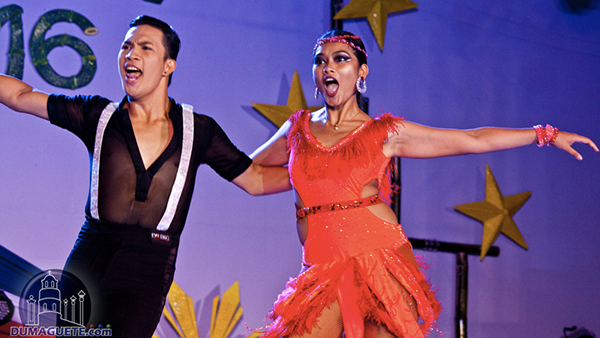Swooping and Dipping: A Ballroom Craze Sweeps Through Asia
MANILA, the Philippines, NOV. 14, 1996 : What was former Senator Rene Saguisag doing on the dance floor at the Inter-Continental Hotel, twirling a woman who is not his wife through the rapid paces of a tango?
''It's exquisite!'' exclaimed the former Senator, once the chief spokesman for Corazon C. Aquino in her improbable rise to the presidency. ''It's good, clean fun and we have lost a lot of weight.''
His wife, Dulce, like him in her 50's, was not far away, gliding across the floor with a man half her age -- another addict of a craze for ballroom dancing that is sweeping through Asia.
''My wife loves me a million more times when I take her out dancing,'' Mr. Saguisag said. ''But we rarely dance with each other; we both have excellent dance instructors. My wife is born to dance. Wow!''
No one seems sure just how the current ballroom dancing fad got started, but in the last two or three years it has adapted itself around the region, taking on the colorations of different national cultures and

In China, people can be seen hopping from their bicycles on the way to work to do a few dance turns among early-morning practitioners of tai chi in Beijing parks and on the Shanghai Bund. The China Daily recently suggested that dance classes could be a healthy way to channel the interests of young people away from premarital sex.
Millions dance in Japan, where ballroom dancing has been regimented into a 12-tier ranking system. Many are inspired by a sentimental Japanese movie about a drab office worker who finds meaning for his life on the dance floor.
Dancing comes with dim sum at Ocean City Restaurant in Hong Kong and draws celebrities to Paul Bishop's Academy of Dance.
In Thailand the venue is Lumpini Park in Bangkok, where there is already talk of Olympic medals at the Games in 2000 in Sydney, where ballroom dancing will be a new event.
And in Singapore, the authorities have added ballroom dancing to wine tasting and tennis as an appropriate activity for Government-run matchmaking clubs.
But nowhere is ballroom dancing bigger than in the Philippines, where ''people power'' and coup attempts are things of the past. Morning, afternoon and evening, in discos, living rooms and stadiums, Filipinos are dancing.
They gather under the palm trees in Luneta Park when the born-again Christians are not holding a rally.
At the Western Police District, officers have been ordered to dance to keep fit and they waltz and fox trot through the headquarters with their pistols at their belts.
''It's really big; it's huge,'' said Paulynn Sicam, a newspaper columnist and former Government commissioner.
''You say: 'I have to leave this dinner early. I have to go ballroom dancing.' And they'll say: 'Oh, no, how wonderful! Can I go too?' ''
Ballroom dancing is biggest here among middle-aged and elderly women who leave their husbands at home -- sometimes surreptitiously -- to samba and jive.
It has spawned the fast expanding profession of dance instructor, mostly athletic young men who carry beepers and maintain stables of loyal clients.
''I have the calling cards of three or four of my favorite dance instructors,'' said Dr. June Lopez, a prominent psychiatrist. ''I just beep them and say, 'I want to go ballroom dancing.' ''
In the early days, when the respectability of their pastime was still in question, the rich matrons of the Sparklers Society at the exclusive Polo Club introduced their dance escorts as their attorneys, and the term stuck. Ballrooms were filled with middle-aged women swooping and dipping in the arms of their young attorneys.
Now everybody does it, and the dance instructors are known everywhere by straightforward initials, D.I.'s. Female D.I.'s are available as well for liberated men like Mr. Saguisag who accompany their wives to the ballroom.
When the Deputy Chief of Staff of the armed forces, Gen. Alfredo Filler, retired earlier this year, he was asked what he wanted to do with the rest of his life.
''I want to learn ballroom dancing,'' he said.
Even at the University of the Philippines, once the spawning ground of the country's Communist movement, teachers and students alike are ballroom dancing, a clear sign that the country is mellowing.
One leading leftist professor cancels all meetings on Wednesday afternoons when the university hosts a dance session.
In a country that loves gossip, there is no shortage of stories about middle-aged women who have had affairs with their young dance instructors. Everyone seems to have heard of someone who has bought a car or a condominium for her D.I.
But for the most part, serious dancing takes precedence over romance. Some people even credit ballroom dancing with fostering marital harmony.
''I know women who bring their dance instructors to Rotary Club meetings and dance the night away while their husbands sit and drink with their buddies,'' Dr. Lopez said.ß
''One woman comes with her D.I. and says, 'Would you like me to beep another one for you?' ''
Throughout the country, discos and nightclubs have converted to ballroom dance spots, and many of them have afternoon hours for those wives who slip out to ''go shopping'' and must be home in time to fix their husbands dinner.
It is a liberated role reversal in a nation where men often play hooky to visit their mistresses, and the excuses tend to be the same: a birthday, a wedding, a wake.
''The husbands say, 'You seem to have a lot of friends dying,' '' said Dr. Lopez, who prescribes ballroom dancing to her depressive patients.
Indeed, the husband of her friend Carmen Villegas, who owns her own clothing factory, died on the dance floor two years ago while dancing the swing.
''He died with a smile on his face,'' Mrs. Villegas said.
''He died in ecstasy,'' Dr. Lopez said.
Copyright The New York Times